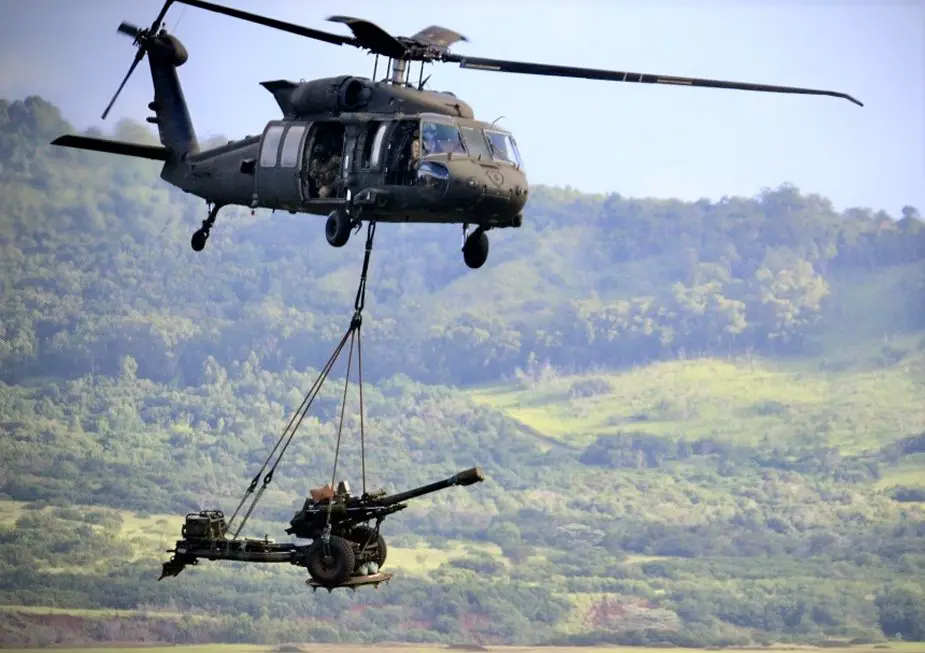Breaking news
U.S. Army artillery intensifies 105mm M119A3 howitzer sling loading training.
U.S. soldiers assigned to A Battery, 2nd Battalion, 11th Field Artillery Battalion, 2nd Infantry Brigade Combat Team, 25th Infantry Division, conduct a three-gun raid air assault exercise June 10, 2020, at Schofield Barracks, Hawaii. During this exercise, U.S. soldiers have conducted sling loaded operations of M119A3 105 howitzers showing the ability of the U.S. Army to rapidly project military forces over any terrain in any conditions.
Follow Army Recognition on Google News at this link

Soldiers assigned to B Battery, 2nd Bn, 11th Field Artillery Bn, 2nd Infantry Bde Combat Team, 25th Infantry Div., conduct a three-gun raid air assault exercise June 12, 2020, at Schofield Barracks, Hawaii. Here, an M119A3 howitzer is sling-loaded by a Sikorsky UH-60 Black Hawk (Picture source: U.S. Army/1st Lt. Steph Sweeney)
The Soldiers flew from X-ray Training Area and rapidly emplaced their firing positions at the East Range Training Area. The coordinated exercise, alongside the Alpha Company Soldiers of 2nd Battalion, 25th Aviation Regiment, 25th Infantry Division Combat Aviation Brigade, was the culmination to the Artillery Table XV certification for the Battery. They sling-loaded three M119A3 howitzers, which shows the Army's ability to rapidly project forces over any terrain in any conditions.
The M119 howitzer is the US designation for the L118 light gun, a lightweight British 105 mm howitzer also used by the United States Army. It can be easily airlifted by helicopter or dropped by parachute. It does not need a recoil pit.
Alpha Battery of the 1st Battalion, 320th Field Artillery Regiment, 101st Airborne Division received their first upgraded M119A3 howitzers in July 2013 and became the first unit to operate it in a theater when they were deployed to northeast Afghanistan in early February 2014. The digitally upgraded M119A3 includes software and hardware component upgrades, GPS for navigation, a digital gunner's display, and digital communication between each gun and the fire direction center to speed up the process of receiving firing data and firing shells. Firing platoons were also equipped with larger, also digital M777A2 howitzers, and the M119A3 was more admired for being faster, lighter, and easier to change azimuth of fire. The A3-model retains manual capabilities of the A2-model, so occasions where digital capabilities were lost allowed crews to easily transition back to the analog mode of operation and continue their missions.
The project manager for Towed Artillery Systems (PM TAS) has developed several upgrades for the M119A3 including digital fire control, increased low-temperature capability from −25 to −51 °F (−32 to −46 °C), and the M20 breech. The recoil system is also being upgraded, as the legacy system had reliability issues with the recuperator, buffer, and variable recoil linkage (which sets recoil length based on elevation); it had a lot of moving parts needing constant maintenance and adjustment during operations with high replacement rates of spares that are complex to manufacture and require specialized tooling to assemble, increasing costs and causing availability problems. The redesigned system operates the same, but modifies and simplifies some components, including a new buffer and recuperator with a majority of the components, removed, and adds the Suspension Lockout System (SLOS) that fixes recoil length at 25 in (64 cm), which removes variable-recoil hardware, reduces stress on the carriage, and lowers buffer rod forces; the new system reduces cost, number of parts by 40 percent to 75, and overall weight by 45 lb (20 kg).
Named after the Native American war leader Black Hawk, the Sikorsky UH-60A entered service with the U.S. Army in 1979, to replace the Bell UH-1 Iroquois (Huey) as the Army's tactical transport helicopter. This was followed by the fielding of electronic warfare and special operations variants of the Black Hawk. Improved UH-60L and UH-60M utility variants have also been developed. Modified versions have also been developed for the U.S. Navy, Air Force, and Coast Guard. In addition to U.S. Army use, the UH-60 family has been exported to several nations. Black Hawks have served in combat during conflicts in Grenada, Panama, Iraq, Somalia, the Balkans, Afghanistan, and other areas in the Middle East.

























